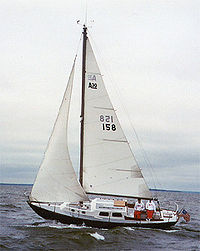Sloop

A sloop is a sailboat usually with one mast and fore-and-aft rigged sails.[1] It can also describe a square rigged sailing ship of two or more masts which is sometimes called a sloop of war.[1] The French called them corvettes.[2] Originally the definition of a sloop was vague. A 1750 book said sloops "are sailed and masted as men's fancies lead them, sometimes with one mast, with two, and with three."[2] Modern recreational sloops are almost always one-masted sailing ships with fore-and-aft sails.[3] Their simple layout makes them popular with amateur sailors.[3] The sloop is a manageable sailboat layout up to a length of about 45 feet (14 m).[3]
History
[change | change source]The sloop design dates back to the early part of the 17th century.[3] By the 20th century they became very popular. Their main advantages are their ease of handling and ability to sail upwind (into the wind).[3]
An early 17th century design was the Bermuda sloop, so-named for the Bermuda trade with North America.[4] It was designed to be fast and could sail in both directions.[4] They needed to be fast to outrun French privateers. The hull was made from Bermuda cedar.[4] The wood was light and resisted rot.[4] They had from one to three masts.[4]

Most modern sailboats are based on the Bermuda sloop design.[4] The Bermuda rig replaced the earlier gaff rig which used a four-cornered sail (instead of a triangular sail) and a spar.[5] A gaff rig design allows more sail on a mast. Another advantage is the gaff rig and other early designs can spill wind faster in a blow (heavy wind).[5]
The sloop of war was the most numerous design in the Royal Navy by the end of the Napoleonic Wars.[6] Yet very little has been written about them or their French counterpart, the Corvettes.[6] Later, the United States used sloops of war.[6] The Royal Navy used the class of "sloop" right up until the end of World War II.[6] The sailing sloop, like its larger cousin the frigate, were fast and used in a variety of roles.[6] They were not usually used in battle, but were more often used for support in reconnaissance and for carrying messages.[6] They were probably the best of the Royal Navy sailing ships for maneuverability and could function in all but the roughest sea conditions.[6]
Related pages
[change | change source]
- Frigate
- Schooner
- Brig
- Brigantine
- Cutter (boat)
- J-class yacht
- Lugger
- Keelboat
- Yacht
- Skerry cruiser
- Smack (ship)
- Yawl
- Thames sailing barge
- Pocket cruiser
Reference
[change | change source]- ↑ 1.0 1.1 Concise Oxford English Dictionary, eds. Angus Stevenson; Maurice Waite (Oxford; New York: Oxford University Press, 2011), p. 1359
- ↑ 2.0 2.1 Romola Anderson; R. C. Anderson, A Short History of the Sailing Ship (Mineola, NY: Dover Publications, 2012), p. 109
- ↑ 3.0 3.1 3.2 3.3 3.4 Pat Reynolds (May 20, 2015). "What's in a Rig? The Sloop". American Sailing Association. Retrieved December 25, 2016.
- ↑ 4.0 4.1 4.2 4.3 4.4 4.5 "Strange Love Craft: The Bermuda Sloop". The Scuttlefish. August 15, 2011. Retrieved December 25, 2016.
- ↑ 5.0 5.1 John Rousmaniere; Mark Smith, The Annapolis Book of Seamanship, Third Edition (New York: Simon & Schuster, 1999), p. 42
- ↑ 6.0 6.1 6.2 6.3 6.4 6.5 6.6 Ian Mclaughlan, The Sloop of War: 1650-1763 (Barnsley, South Yorkshire: Pen & Sword Books Ltd., 2014), p. 6
